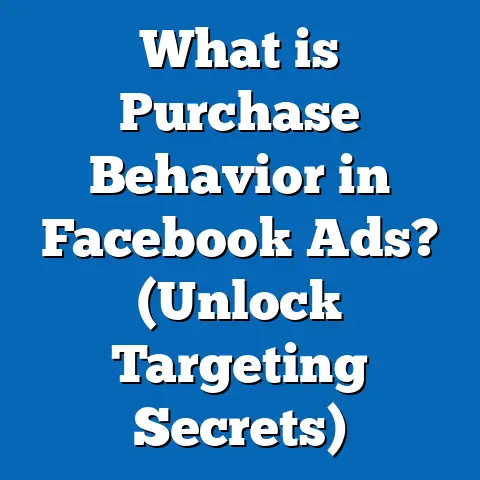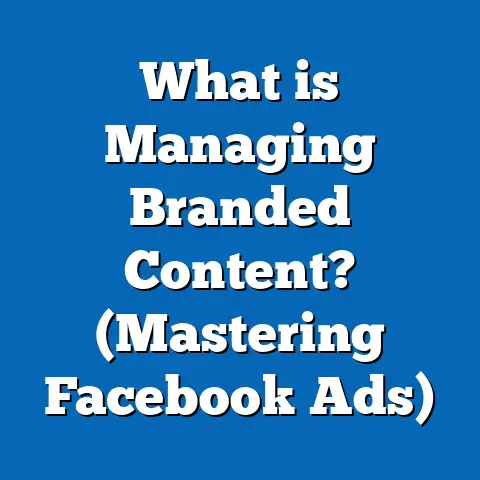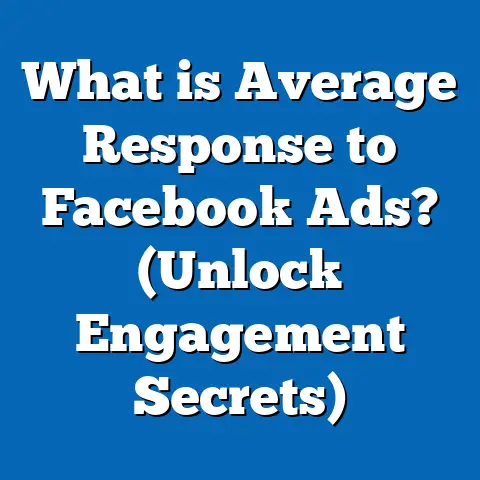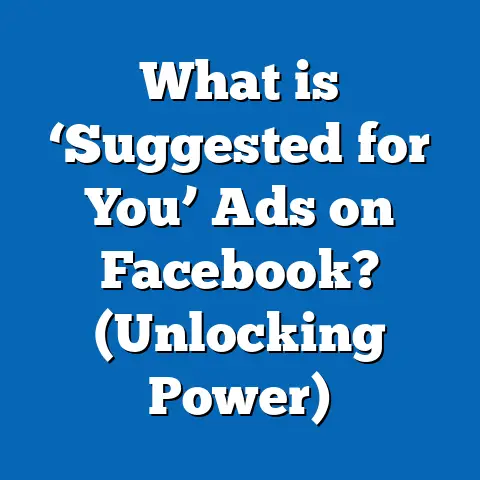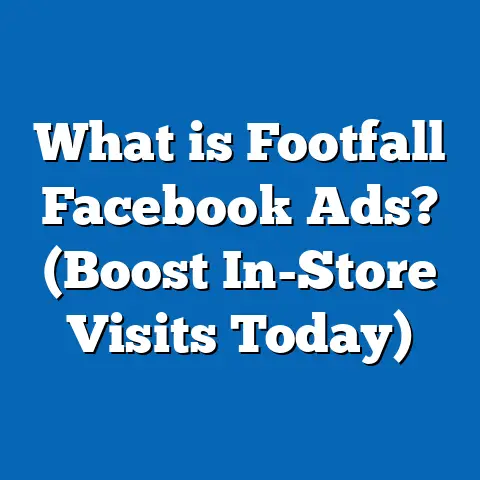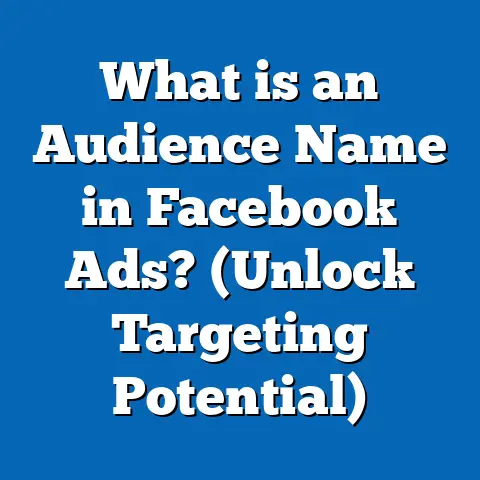What is a Facebook Ad Headline? (Unlocking Targeted Impact)
Introduction: The Power of a Facebook Ad Headline
In the fast-paced world of digital marketing, every second counts. With over 2.96 billion monthly active users on Facebook as of early 2024, businesses have an unprecedented opportunity to reach diverse audiences. However, this vast audience brings intense competition for attention. The Facebook ad headline is your primary tool to break through the noise and connect meaningfully with your target market.
Why does the headline matter so much? Because it’s often the first—and sometimes the only—piece of text a user reads before deciding whether to engage with your ad. A strong headline can dramatically improve your ad’s effectiveness by grabbing attention, setting expectations, and encouraging users to take action. Conversely, a weak headline can render even the most visually stunning ad invisible.
This guide explores everything you need to know about Facebook ad headlines—from foundational concepts to advanced strategies—to help you create headlines that deliver measurable results. Whether you’re managing ads for a small business or leading large-scale marketing campaigns, mastering Facebook ad headlines is essential for success.
What is a Facebook Ad Headline?
Definition and Purpose
A Facebook ad headline is the key textual element within an ad format that communicates your core message in a concise way. It is positioned near your ad’s visual content and serves as a hook.
For example, in a typical Facebook ad layout, the headline appears prominently beneath or beside the image/video and above the description or call-to-action button. This placement makes it critical to capture interest quickly.
Why the Headline Matters More Than Ever
With users scrolling quickly through their feeds—an average of 1.7 seconds per post (Microsoft Study, 2023)—your headline must cut through the clutter immediately. A well-crafted headline not only grabs attention but also aligns user expectations with your offering, ensuring that clicks lead to meaningful engagement rather than bounce.
Types of Facebook Ad Headlines
Facebook offers several ad formats including:
- Single Image Ads: Headline below the image.
- Video Ads: Headline appears below or overlayed on video.
- Carousel Ads: Each card may have its own headline.
- Collection Ads: Headline introduces a group of products.
Understanding how headlines function across these formats helps tailor your message effectively.
Why Facebook Ad Headlines Matter: Data-Backed Insights
User Engagement and Attention
Facebook’s algorithm optimizes for engagement signals. Headlines that resonate can boost likes, comments, shares, and clicks, signaling relevance to the platform.
Key data points:
- Personalized headlines increase engagement by 12% (HubSpot, 2023).
- Headlines using questions boost CTR by 20-25% (BuzzSumo, 2023).
- Ads with emotional triggers in headlines see up to 25% more engagement (Psychology Today).
Conversion Influence
The headline’s role extends beyond clicks. It influences user psychology by framing expectations and motivating action.
- A/B testing by AdEspresso shows headline changes alone can increase conversions by up to 40%.
- Urgency-driven headlines like “Today Only” improve conversion rates significantly in time-sensitive promotions.
- Clear benefit-focused headlines outperform generic ones by 35% in lead generation campaigns (WordStream).
Impact on Cost Efficiency
Better-performing headlines improve Facebook’s relevance score and quality ranking, often leading to:
- Lower cost per click (CPC)
- Lower cost per acquisition (CPA)
- Improved Return on Ad Spend (ROAS)
For instance, advertisers report CPC reductions of up to 20% after optimizing headlines for relevance.
Anatomy of an Effective Facebook Ad Headline
Key Components Explained
- Clarity
- Avoid ambiguity.
- Use simple language that conveys your message instantly.
- Example: Instead of “Discover Our Solutions,” say “Increase Sales with Our Tools.”
- Relevance
- Align with the audience’s current needs or problems.
- Use data from audience research to tailor language.
- Example: For fitness enthusiasts, “Get Fit Fast with Our App” beats “Try Our App Today.”
- Brevity
- Facebook prefers headlines under 40 characters for optimal mobile display.
- Conciseness ensures your message isn’t truncated.
- Example: “Save 50% Today Only” is more effective than “Enjoy Huge Savings on All Products Today.”
- Value Proposition
- Clearly state what users gain.
- Avoid vague promises; be specific.
- Example: “Double Your Leads in 30 Days” vs. “Improve Your Business.”
- Call to Action (CTA)
- Sometimes included in headlines for extra push.
- Examples: “Download Now,” “Join Free Webinar,” “Shop Limited Offer.”
- Subtle CTAs can motivate without overwhelming.
Structuring Your Headline
- Start with a hook (question, number, bold statement).
- Follow with benefit or solution.
- If space allows, add urgency or exclusivity.
Creating Targeted Headlines: Strategies and Techniques
Deep Audience Understanding
Before writing, define your audience precisely using Facebook’s Audience Insights tool:
- Demographics: Age, gender, location
- Interests and behaviors
- Device usage patterns
- Purchase history (if available)
Tailor headlines to these segments for relevance.
Example: For young professionals interested in productivity apps:
- Headline: “Boost Work Efficiency with One Click”
For senior customers interested in health:
- Headline: “Stay Healthy with Simple Daily Habits”
Emotional Triggers and Psychological Drivers
Humans make decisions based on emotions first, then justify logically.
Common emotional triggers include:
- Curiosity: “What You Didn’t Know About Facebook Ads”
- Fear of Missing Out (FOMO): “Last Chance to Save Big”
- Trust: “Used by 1 Million Businesses Worldwide”
- Excitement: “Unlock New Opportunities Today”
Strategically using these in headlines increases engagement rates by up to 25% (Psychology Today).
Incorporating Data and Numbers
Numbers lend credibility and specificity:
- Statistics: “Join 20,000+ Happy Customers”
- Percentages: “Save 30% on Your First Order”
- Timeframes: “Achieve Results in Just 7 Days”
Studies show ads featuring numbers in headlines experience a 17% higher click rate (Content Marketing Institute).
Using Questions Effectively
Questions invite interaction and curiosity.
Examples:
- “Ready to Grow Your Business?”
- “Want More Traffic Without Extra Spend?”
- “Struggling with Facebook Ads?”
Questions increase CTR by up to 20% compared to statements alone (BuzzSumo).
Comparing Facebook Ad Headlines with Other Platforms
Google Ads Headlines
Google Ads focus on intent-based search queries. Headlines must include keywords matching user searches and fit strict character limits (up to 30 characters per headline).
Key differences:
- Google Ads are keyword-driven; Facebook ads are interest-driven.
- Google requires precision for relevance; Facebook allows creative freedom.
- Google headlines appear alongside organic search results; Facebook headlines appear in social feeds rich with visual content.
Instagram Ad Headlines
Instagram prioritizes visuals over text. While Instagram allows captions and text overlays on images/videos, standalone headlines are less emphasized compared to Facebook.
Key points:
- Instagram ads rely heavily on imagery and storytelling.
- Facebook ads integrate headlines as a critical textual element.
- Instagram captions can be longer but appear below or inside posts.
This means Facebook ad headlines need to be punchier and clearer as they serve as primary drivers of engagement alongside visuals.
Advanced Techniques for Optimizing Facebook Ad Headlines
A/B Testing Headlines: Methodology and Best Practices
A/B testing involves running two or more versions of an ad simultaneously to see which performs better.
Steps:
- Choose one variable — headline — while keeping other elements constant.
- Run tests across similar audience segments.
- Measure performance metrics like CTR, conversion rate, CPA.
- Analyze results and pick winning headlines.
- Iterate with new variations.
Best practices:
- Test at least 3-5 headline variants per campaign.
- Run tests long enough to gather statistically significant data (~1 week).
- Combine A/B testing data with qualitative feedback if possible.
Dynamic Creative Optimization (DCO)
Facebook’s Dynamic Creative feature automatically tests multiple combinations of headlines, images, descriptions, and CTAs.
Benefits:
- Automated optimization based on real-time performance data.
- Saves manual testing time.
- Delivers tailored creative combinations per audience segment.
Usage tip: Upload multiple headline options when creating ads to let Facebook optimize delivery.
Keyword Integration for Ad Relevance
Though not traditional SEO keywords, integrating relevant terms improves Facebook’s relevance score.
How:
- Use industry-specific terms users associate with your brand.
- Avoid keyword stuffing; keep language natural.
- Example: For a fitness app targeting runners: “Running Tracker App for Every Level”
A higher relevance score can lower CPC and improve ad delivery efficiency.
Case Studies: Real-World Applications of Effective Facebook Ad Headlines
Case Study 1: E-commerce Brand Boosts Sales by 35%
Background: A fashion retailer wanted to increase sales during a seasonal sale period.
Before: Generic headline — “Check Out Our New Collection”
Strategy: Used urgency + discount + personalization in headline:
“Flash Sale: 30% Off Your Favorite Styles Today Only”
Results:
- CTR increased by 28%
- Conversion rate increased by 35%
- ROAS improved by 45%
This case highlights how urgency combined with clear value drives rapid action.
Case Study 2: SaaS Company Increases Leads by 50%
Background: A SaaS company targeting small businesses wanted more qualified leads.
Original Headline: “Try Our Software”
New Headline: “Get More Leads in 7 Days – No Tech Skills Needed”
Results:
- Lead submissions increased by 50%
- Lead quality improved due to clarity in promise
- Cost per lead decreased by 22%
Clear benefit + ease-of-use messaging resonated strongly with target audience.
Case Study 3: Nonprofit Increases Donations by 60%
Background: A nonprofit sought more donations via Facebook ads during fundraiser season.
Original Headline: “Support Our Cause”
Revised Headline: “Help Feed 100 Children Today – Donate Now”
Results:
- Donations increased by 60%
- CTR rose by 35%
Adding specificity (“Feed 100 Children”) made impact tangible and urgent.
Practical Tips for Writing Your Own Facebook Ad Headlines
- Start with Research: Know your audience’s pain points and language preferences.
- Use Power Words: Words like “Free,” “Easy,” “Now,” and “You” increase engagement.
- Keep It Mobile-Friendly: Shorter headlines avoid truncation on small screens.
- Match Visuals & Headlines: Ensure coherence between text and image/video themes.
- Avoid Jargon: Use simple language accessible to your target demographic.
- Test Emotion vs Logic: See if emotional appeals or logical benefits convert better.
- Create Sense of Urgency: Encourage immediate action without being pushy.
- Use Social Proof: Incorporate numbers or testimonials where possible.
Common Mistakes to Avoid in Facebook Ad Headlines
| Mistake | Why It Hurts | Fix |
|---|---|---|
| Being too vague or generic | Fails to engage or clarify offer | Be specific about benefits and offers |
| Using jargon or complex words | Confuses or alienates audience | Use clear, simple language |
| Ignoring audience relevance | Message misses target audience | Tailor language based on audience research |
| Misleading claims | Creates distrust, violates policies | Ensure honesty and transparency |
| Headlines too long | Gets truncated on mobile devices | Keep under 40 characters |
| No alignment between text & visuals | Causes confusion or skepticism | Synchronize messaging across all creative assets |
Latest Trends in Facebook Ad Headlines (2024)
Personalization at Scale
Using dynamic text insertion based on user data creates personalized experiences that increase CTR by up to 15%.
Example: “John, Ready for Your Next Adventure?”
Video Thumbnails with Text Overlays
Adding short headline snippets directly on video thumbnails boosts engagement by up to 37% (Facebook IQ).
Tip: Combine strong video content with concise overlay text for maximum impact.
Interactive Elements in Headlines
Polls or quiz-type questions integrated within ads engage users beyond clicks:
Example: “Which Marketing Strategy Works Best for You? Take Our Quiz!”
AI-Powered Copywriting Tools
Marketers leverage AI tools like ChatGPT or Jasper.ai for quick headline ideation and variation creation—allowing rapid testing cycles.
Caution: Always review AI-generated content for tone consistency and brand alignment.
Exercises for Marketers: Crafting Winning Headlines
Try these exercises to sharpen your skills:
- Write five headlines for a product launch using numbers/statistics.
- Create three versions of a headline targeting different buyer personas.
- Test emotional vs logical appeal headlines within your next campaign.
- Rewrite an old underperforming headline adding urgency elements.
- Use Dynamic Creative Ads feature on Facebook Ads Manager with at least five headline variations.
Tools and Resources for Headline Optimization
| Tool | Purpose | Link |
|---|---|---|
| Facebook Audience Insights | Research audience demographics | business.facebook.com/insights |
| Canva | Design visuals & text overlays | canva.com |
| AdEspresso | A/B testing platform | adespresso.com |
| BuzzSumo | Content analysis & trends | buzzsumo.com |
| Headline Analyzer Tools | Score headline effectiveness | sharethrough.com/headline-analyzer |
Conclusion: Unlocking Targeted Impact Through Effective Headline Crafting
The Facebook ad headline is a small but mighty part of your advertising strategy. By investing time into crafting clear, relevant, emotionally resonant, and targeted headlines, you set the stage for higher engagement, better conversion rates, and improved advertising ROI.
Summary of Best Practices:
- Focus on clarity and relevance above all else.
- Use emotional triggers and numbers strategically.
- Tailor messages precisely based on detailed audience research.
- Continuously test and optimize using data-driven methods.
- Stay current with evolving trends like personalization and AI copywriting tools.
Mastering Facebook ad headlines empowers marketers to unlock powerful targeted impact—and ultimately grow their businesses more effectively through one of the world’s largest digital platforms.

